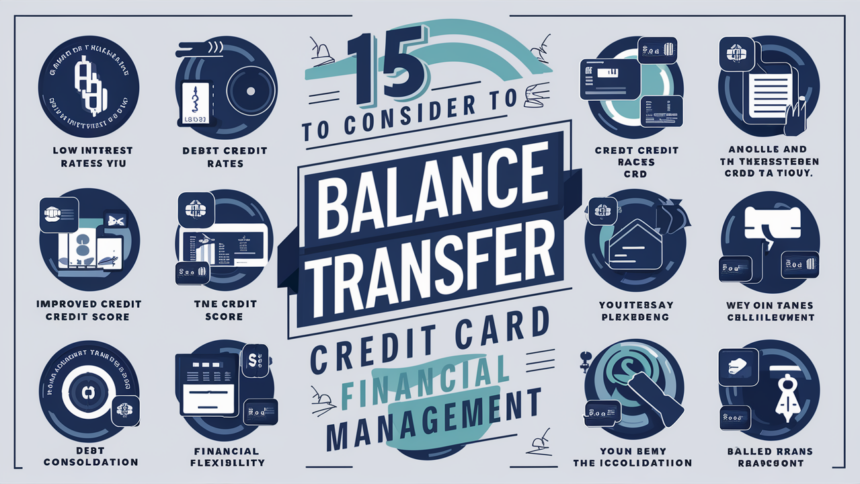A balance transfer credit card is what? Often with a reduced interest rate, a debt transfer credit card lets you move outstanding amounts from one credit card to another. This will enable you to pay off debt faster and cut interest charge expenses.
Do you owe debt on credit cards? Are you overwhelmed by the high interest rates? If so, your financial rescue can be a balance transfer credit card. Moving your current balances to a new card with a reduced interest rate could help you perhaps save hundreds or even thousands of dollars in interest payments. The top 10 reasons to think about a debt transfer credit card and how it might enable you to take charge of your money will be discussed in this post.
The Top Reasons You Should Think About a Balance Transfer Credit Card
1. Lower Interest Rates:
People turn to balance transfer cards mostly for lower interest rates—the basic reason You can considerably cut the amount of interest paid over time by moving your balance to a card with a very lower interest rate. Faster debt payback and significant savings are thus possible. By allocating more of your monthly payment towards the main sum instead of paying outrageous interest to your former creditor, you will be accelerating the payback and generally relieving your finances.
2. Debt Consolidation:
A balance transfer card can change things if you are juggling several credit cards with large balances. Consolidating your debt onto one card helps you simplify your financial situation and maybe lower your late charge and missed payment risk. This simplified technique will enable you to remain orderly and focused on your debt payback objectives. One monthly payment will help you avoid the uncertainty and stress related to handling several due dates and minimum payments.
3. Improved Cash Flow:
Reduced interest payments from a balance transfer card can release a sizable amount of your monthly income. This increased financial freedom lets you devote more money to other financial goals as creating an emergency fund, saving for a down payment on a house, or future investment. Reducing your interest load will free more discretionary income to reach both long-term and short-term financial goals.
4. Potential for Balance Transfer Bonuses:
Some balance transfer cards include tempting welcome bonuses or perks for moving a sizable sum. These benefits could offer more value and incentives to weigh a balance transfer. Using these bonuses may help you offset the balance transfer expenses and possibly get rewards while the debt is being paid off.
5. Longer Interest-Free Period:
Many balance transfer cards include an introductory interest-free period, which presents a great chance to pay off your debt without running interest. This might be a calculated technique to effectively pay off your debt and save money. Using the interest-free time sensibly will help you greatly lower the overall interest you pay and hasten your path of debt payback.
6. Simplified Repayment:
Managing one credit card payment usually relieves more tension than coordinating several installments. By simplifying your payback process, a balance transfer card helps you keep better control over your money and prevent late penalties. Making a consolidated payment helps you to guarantee proper management of your debt and lower the possibility of mistakes.
7. Improved Credit Utilisation:
Lowering your credit card balances by a balance transfer will help your credit use ratio, which is a major component influencing your credit score. Reducing your credit use will help you over time increase your creditworthiness. A reduced credit use ratio shows good credit management and can help future loan and credit card interest rates be lower.
8. Possibilities for Credit Score Enhancement:
Together with general debt reduction, regular on-time payments on your balance transfer card can help to improve your credit score. Better financial possibilities—including reduced loan and credit card interest rates—are opened by a higher credit score. Establishing a history of good credit behavior will help you to create a strong credit profile and release financial benefits.
9. Peace of Mind:
Reducing your credit card debt by proactive means will help you greatly feel financially secure and relieved. A useful aid in reaching this peace of mind and lowering general financial stress is a balance transfer card. Taking charge of your debt and moving towards financial independence will help you feel more confident in your financial future.
10. Additional Benefits:
Many balance transfer cards provide extra benefits including trip insurance, extended warranties, or purchase protection. These extra advantages can improve the card’s overall worth and offer more defence against theft of your purchases. Selecting a balance transfer card with worthwhile features will help you to fully utilize your card and provide extra piece of mind.
11. Emergency Financial Cushion:
A balance transfer credit card might assist you create an emergency fund by liberating cash flow through reduced interest rates. This financial safety net will guard against unanticipated costs and help you avoid depending on high-interest credit should an emergency strike.
12. Focus on Other Financial Goals:
With lower debt, you may devote more money to save for big expenditures such as a house, car, or education. A balance transfer card can enable you to speed your way towards reaching your financial objectives.
13. Potential for Cashback and Rewards:
Certain balance transfer cards include cashback or reward programs. Although debt should always be given top priority, these benefits can provide more value and help to balance some of your expenses.
14. Improved Budgeting:
Simplifying budgeting by grouping your debt into one payment will help you. You will be better able to see your monthly spending and can build a more sensible budget to handle your money.
15. Professional Financial Assistance:
Many balance-transfer card providers provide debt management tools or financial counselling. As you move towards debt-free, these programs can offer insightful direction and encouragement.
Conclusion
Managing your debt and enhancing your financial status can be much aided by a balance transfer credit card. Choosing the correct card and properly weighing your alternatives may help you perhaps save hundreds of dollars in interest costs and speed toward your financial goals. To prevent slipping back into debt, though, it’s crucial to use a balance transfer card sensibly and draft a strong repayment schedule.
FAQs
A balance transfer charge is what?
Charged by the credit card provider, a balance transfer fee is a percentage of the total you move.
Transferring a balance takes what length of time?
Although the credit card issuer will affect the transfer time for a debt, it usually takes a few business days.
With the same issuer, might I move a balance from one credit card to another?
Indeed, you can usually move a balance between credit cards from the same provider. To be sure your card is approved, though, be sure you review its terms and restrictions.
Will a balance transfer compromise my credit score?
Opening a new balance transfer credit card and moving a debt will momentarily affect your credit score. On the other hand, your credit score should recover and maybe get better if you use the card wisely and pay off your debt on schedule.
Transfer the debt or pay off my highest interest rate card first?
The ideal strategy relies on your financial circumstances. Paying off your highest interest rate card first may be the wisest course of action if you can afford to make additional payments on another card. A balance transfer credit card, though, could help if you find it difficult to make minimal payments.





